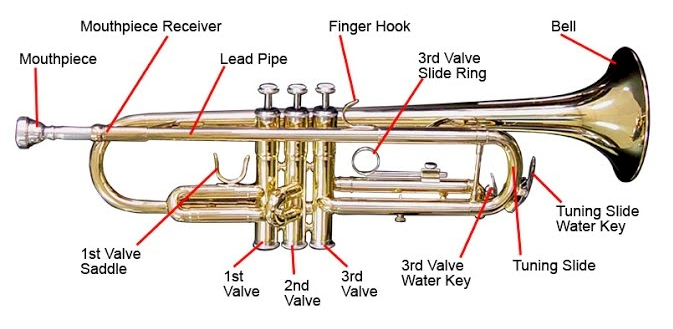









|
PARTS OF THE TRUMPET
 |
 |
THE TRUMPET VALVE
Have you ever taken your trumpet valves apart? Well, if you do, it will look like this. With the exception of the piston itself, all the smaller parts can be easily replaced if necessary. If you are a seasoned player, remember that even the slightest change in your trumpet will change the feel of the horn. All of the parts pictured here go inside the valve case. Here are the parts top to bottom:
Finger button The valve cap looks a little different for each company and if you need to replace yours just make sure they match and fit your trumpet. A lot people lose these but they are easy to find and you can sometimes find them in cool colors.
Valve cap felt The felt that supports the valve cap isn t always a felt. Some trumpet brands have a strong black rubber instead of a felt. These can also be easily replaced, found almost anywhere online and even in music stores. I remember having red and green ones when I was young.
Top valve cap These are pretty straight forward to replace. Simply look for the brand of trumpet you have and either call the company or look up parts online. Easy peasy.
Stem felt This little felt provides a cushion between the top valve cap and the bottom of the stem. Without it there would be a loud clunking noise every time the valve comes back up. These are cheap and easy to find as well.
The stem Without the stem, the valve wouldn t work at all. To replace the stem look for the same brand that you have now and carefully pull the valve apart to insert the new stem. These rarely need replacement.
The spring Obviously, there would be no spring action without the spring! Trumpet springs come from many different makers and some claim to be faster than others. Just try a few and see!
Valve guide The guide does just that, it guides the valve. Most trumpets will have one precise way the guide goes in the valve case and if you do it wrong then you won t be able to put air through the trumpet. You can often fix this by simply turning the valve until you clear a click, but I always recommend pulling the valve out and looking in the casing to see which way the guide should go. This way, you avoid turning the piston side to side and potentially scratching the valve or the casing.
The valve Finally, the most important part of the trumpet valve, the piston. If you need to replace the piston or do any work to it, take it to a shop and have a pro look at it for you. Some reasons to do this would be if your valve isn t working smoothly even though you oil it regularly and have tried cleaning it and the casing. Without proper care, the piston can lose its ability to slide and it can sometimes be very expensive to fix.
|
OTHER PARTS COMMONLY REPLACED
Stopper
The stopper is a small screw attached to a rod that stops the third slide valve from sliding off the trumpet. In Bach trumpets there are two of them, while Yamaha horns use a single one that looks a little different. These often fall off but luckily can be easily replace with a quick online search.
Third Slide Ring
The third slide ring is sometimes removable, like this one. Although most professional trumpets have it attached to the third slide, most student models will have a removable one, which means it s likely to get lost. It s simple to find a replacement though, so no worries!
Water Key Corks
Water key corks are there to prevent leaking from the main tuning slide. Over time these corks lose shape and stop putting enough pressure to stop a leak, and that s when they need to be replaced. Some corks are self-adhesive which is very useful and easy to replace. Others will need super glue or heated glue, which you should be very careful using. Be sure to have an adult present to help you. Finally, your trumpet may have an amado key, (a push button style water key) and will not need water key corks.
Mute Corks
Mute corks are not for the trumpet but are still replaced very often, which is why they are listed here. These corks keep a mute snug in the bell, but sometimes fall off from wear and tear. Although some come with adhesives for easy application, some don t, in which case you just need strong glue and a bit of sand paper to sand them down should they be too big. Always be careful when using super glue! Note that harmon mutes do not use this type of cork. Harmon corks are flat, wide, and wrap around the entire edge of the mute.
|
|


